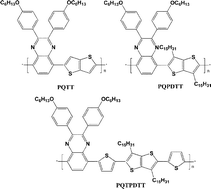Low band-gap polymers based on quinoxaline derivatives and fused thiophene as donor materials for high efficiency bulk-heterojunction photovoltaic cells
Abstract
In this study we synthesized three low band-gap

* Corresponding authors
a
Department of Materials Chemistry and Engineering, Konkuk University, 1 Hwayang-dong, Gwangjin-Gu, Seoul, South Korea
E-mail:
dkmoon@konkuk.ac.kr
Fax: +82-2-444-0765
Tel: +82-2-450-3498
b
Energy Materials Research Division, Korea Research Institute of Chemical Technology, P. O. BOX 107, Sinseongno 19, Yuseong, South Korea
E-mail:
shinws@krict.re.kr
Fax: +82-42-860-7868
Tel: +82-42-860-7106
In this study we synthesized three low band-gap

 Please wait while we load your content...
Something went wrong. Try again?
Please wait while we load your content...
Something went wrong. Try again?
J. Lee, W. Shin, J. Haw and D. Moon, J. Mater. Chem., 2009, 19, 4938 DOI: 10.1039/B823536H
To request permission to reproduce material from this article, please go to the Copyright Clearance Center request page.
If you are an author contributing to an RSC publication, you do not need to request permission provided correct acknowledgement is given.
If you are the author of this article, you do not need to request permission to reproduce figures and diagrams provided correct acknowledgement is given. If you want to reproduce the whole article in a third-party publication (excluding your thesis/dissertation for which permission is not required) please go to the Copyright Clearance Center request page.
Read more about how to correctly acknowledge RSC content.
 Fetching data from CrossRef.
Fetching data from CrossRef.
This may take some time to load.
Loading related content
